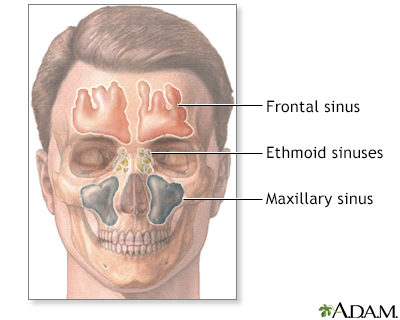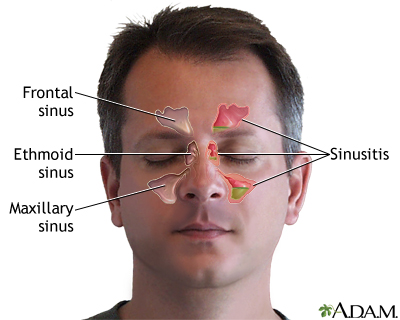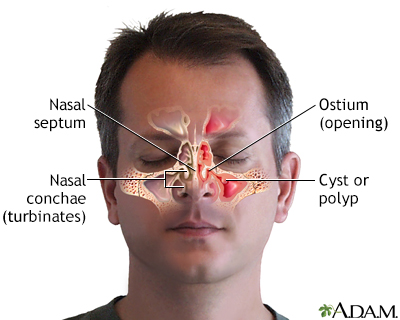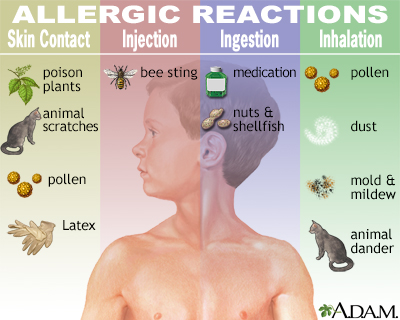Sinusitis
Acute sinusitis; Sinus infection; Sinusitis - acute; Sinusitis - chronic; Rhinosinusitis
Sinusitis is present when the tissue lining the sinuses become swollen or inflamed. It occurs as the result of an inflammatory reaction or an infection from a virus, bacteria, or fungus.

Does it feel like someone is pressing down hard on your forehead? Do you feel intense pain and pressure behind your eyes? You could have sinusitis, swollen, inflamed sinuses caused by an infection. Let's talk about sinusitis. These are your sinuses, the passageways that lie behind your forehead, eyes, and cheeks. They're lined with mucus membranes, which produce the mucus, or snot, that flows freely from your nose when you're sick. So, what causes sinusitis? Normally, air moves through your sinuses like this. But if you have a cold, allergies, or a condition that prevents the little hairs in your sinuses from sweeping out mucus, you could end up with too much of the sticky stuff. That extra mucus can block your sinuses, like this. Then, bacteria and other germs can start to grow inside your sinuses, leading to that pain and pressure you feel. If your symptoms go away within a month, you've got acute, or short-term sinusitis. But if they last three months or longer, you've got chronic sinusitis. That means your pain and pressure will stick with you, unless you get treated. What are the signs of having sinusitis? If you've just gotten over a cold or other illness and your forehead and eyes are throbbing with a pressure-like pain, you could have sinusitis. Other signs are tenderness in your face or teeth, fever, tiredness, cough, and a stuffed nose. Your doctor can often tell whether you have sinusitis by looking in your nose, shining a light against your sinuses, or tapping over the area to look for signs of swelling and infection. If your doctor thinks you may need surgery for your sinusitis, or the diagnosis isn't clear, you could also have an x-ray, CT, or MRI scan. There's a good chance your infection will go away on its own if you have acute sinusitis. But if it lingers and you're running a high fever or you're in a lot of pain, your doctor may prescribe antibiotics. You can manage your sinusitis at home with a few easy tips; Hold a warm, moist washcloth to your face a few times a day; Drink extra water and other fluids to thin out your mucus; Breathe in the steam from a hot shower AND Use a Neti pot or saline nose spray. After three months if you're still dealing with sinusitis symptoms, your doctor may recommend seeing an ear-nose-and-throat doctor. You might need surgery to drain your clogged sinuses. Most of the time, sinusitis goes away on its own without any treatment. To prevent your sinuses from getting clogged in the first place, avoid getting colds and other infections. Avoid exposure to allergens or irritants, such as tobacco smoke. Eat a healthy diet filled with antioxidant-rich fruits and vegetables. Get your annual flu shot and wash your hands throughout the day to avoid germs. When you do get sick, consider decongestant sprays to shrink the linings in your nose and sinuses, and drink plenty of fluids to keep mucus moving along.

The sinuses are hollow cavities within the facial bones. Sinuses are not fully developed until after age 12. When people speak of sinus infections, they are most frequently referring to the maxillary and ethmoid sinuses.

Sinusitis refers to inflammation of the sinus cavities, which are moist, hollow spaces in the bones of the skull. There are four pairs of sinuses. They are the frontal sinuses, maxillary sinuses, ethmoid sinuses, and sphenoid sinuses (not shown in illustration). If the opening from a sinus cavity becomes plugged, the flow of mucus is blocked and pressure builds up, causing pain and inflammation.

The sinuses are surrounded by bone and cartilage and lined with a mucous membrane. Sinusitis occurs when the membranes becomes inflammed and painful, which may be a result of a blocked sinus opening. Chronic sinusitis is often caused by inflammation and blockage due to physical obstruction such as a deviated septum, misformed bone or cartilage structures such as the nasal conchae (turbinates), or blockage by nasal cysts or polyps.

Allergic reaction can be provoked by skin contact with poison plants, chemicals and animal scratches, as well as by insect stings. Ingesting or inhaling substances like pollen, animal dander, molds and mildew, dust, nuts and shellfish, may also cause allergic reaction. Medications such as penicillin and other antibiotics are also to be taken with care, to assure an allergic reflex is not triggered.

What in the world is a neti pot? I'm Dr. Alan Greene and I want to show you this simple device that has been used in a natural way to help deal with nasal congestion, sinus congestion, and allergies. Here's an example of the pot. They come in different brands and generic. What you do is you fill it with luke warm water and empty some packets of saline in there so it's a medicated rinse, saline rinse. Then you will want to get over a sink, bend over the sink and stick the pot into your nostril so that you get sort of a seal. And then of all things, you turn your head to the side until one nostril is right above the other while breathing through your mouth. Don't inhale. Don't snort. And what will happen is that it will wash through your sinuses and around and start dripping out the other nostril into the sink. When you're done, exhale and you have rinsed the inside of your nasal passages. Repeat on the other side as necessary.
Causes
The sinuses are air-filled spaces in the skull. They are located behind the forehead, nasal bones, cheeks, and eyes. Most of the time, mucus is able to drain out and air is able to flow through the sinuses.
When the sinus openings become blocked or too much mucus builds up, bacteria and other germs can grow more easily.
Sinusitis can occur from one of these conditions:
- Small hairs (cilia) in the sinuses fail to properly move mucus out. This may be due to some medical conditions.
- Colds and allergies may cause too much mucus to be made or the associated inflammation may block the opening of the sinuses.
- A deviated nasal septum, nasal bone spur, or nasal polyps may block the opening of the sinuses.
- Chronic infection can cause mucosal swelling and inflammation.
There are three types of sinusitis:
- Acute sinusitis is when symptoms are present for 4 weeks or less. It is caused by viruses or bacteria growing in the sinuses.
- Chronic sinusitis is when the symptoms and swelling of the sinuses is present for longer than 3 months. It may be caused by bacteria or a fungus.
- Subacute sinusitis is when the symptoms and swelling is present from 1 to 3 months.
The following may increase the risk that an adult or child will develop sinusitis:
- Allergic rhinitis or hay fever
- Cystic fibrosis
- Going to day care
- Diseases that prevent the cilia from working properly
- Changes in altitude (flying or scuba diving)
- Large adenoids
- Smoking
- Weakened immune system from HIV or chemotherapy
- Abnormal sinus structures
Symptoms
The symptoms of acute sinusitis in adults very often follow a cold that does not get better or that gets worse after 7 to 10 days. Symptoms include:
- Bad breath or loss of smell
- Cough, often worse at night
- Fatigue and general feeling of being ill
- Fever
- Headache
- Pressure-like pain, pain behind the eyes, toothache, or tenderness of the face
- Nasal stuffiness and discharge
- Sore throat and postnasal drip
Symptoms of chronic sinusitis are the same as those of acute sinusitis. However, the symptoms tend to be milder and last longer than 12 weeks.
Symptoms of sinusitis in children include:
- Cold or respiratory illness that has been getting better and then begins to get worse
- High fever, along with a darkened nasal discharge, that lasts for at least 3 days
- Nasal discharge, with or without a cough, that has been present for more than 10 days and is not improving
Exams and Tests
The health care provider will examine you or your child for sinusitis by:
- Looking in the nose for signs of polyps
- Shining a light against the sinus (transillumination) for signs of inflammation
- Tapping over a sinus area to find tenderness that may be due to infection
The provider may view the sinuses through a fiberoptic scope (called nasal endoscopy or rhinoscopy) to diagnose sinusitis. This is often done by doctors who specialize in ear, nose, and throat problems (ENTs).
Imaging tests that may be used to decide on treatment are:
- A CT scan of the sinuses to help diagnose sinusitis or view the bones and tissues of the sinuses more closely
- An MRI of the sinuses if there might be a tumor or fungal infection
Most of the time, regular x-rays of the sinuses do not diagnose sinusitis well.
If you or your child has sinusitis that does not go away or keeps returning, other tests may include:
- Allergy testing
- Blood tests for HIV or other tests for poor immune function
- Ciliary function test
- Nasal culture
- Nasal cytology
- Sweat chloride tests for cystic fibrosis
Treatment
SELF-CARE
Try the following steps to reduce stuffiness in your sinuses:
- Apply a warm, moist washcloth to your face several times a day.
- Drink plenty of fluids to thin the mucus.
- Inhale steam 2 to 4 times per day (for example, while sitting in the bathroom with the shower running).
- Spray with nasal saline several times per day.
- Use a humidifier.
- Use a Neti pot or saline squeeze bottle to flush the sinuses.
Be careful with use of over-the-counter spray nasal decongestants such as oxymetazoline (Afrin) or phenylephrine (Neosynephrine). They may help at first, but using them for more than 3 to 5 days can make nasal stuffiness worse and lead to dependence.
To help ease sinus pain or pressure:
- Avoid flying when you are congested.
- Avoid temperature extremes, sudden changes in temperature, and bending forward with your head down.
- Try acetaminophen, ibuprofen, or naproxen.
MEDICINE AND OTHER TREATMENTS
Most of the time, antibiotics are not needed for acute sinusitis. Most of these infections go away on their own. Even when antibiotics do help, they may only slightly reduce the time it takes for the infection to go away. Antibiotics are more likely to be prescribed sooner for:
- Children with nasal discharge, possibly with a cough, that is not getting better after 2 to 3 weeks
- Fever higher than 102.2°F (39°C)
- Headache or pain in the face
- Severe swelling around the eyes
Acute sinusitis should be treated for 5 to 10 days. Chronic sinusitis should be treated for 3 to 4 weeks.
At some point, your provider will consider:
- Other prescription medicines
- More testing
- Referral to an ear, nose, and throat or allergy specialist
Other treatments for sinusitis include:
- Allergy shots (immunotherapy) to help prevent the disease from returning
- Avoiding allergy triggers
- Nasal corticosteroid sprays and antihistamines to decrease swelling, especially if there are nasal polyps or allergies
- Oral corticosteroids
Surgery to enlarge the sinus opening and drain the sinuses may also be needed. You may consider this procedure if:
- Your symptoms do not go away after 3 months of treatment.
- You have more than 2 or 3 episodes of acute sinusitis each year.
Most fungal sinus infections need surgery. Surgery to repair a deviated septum or nasal polyps may prevent the condition from returning.
Outlook (Prognosis)
Most sinus infections can be cured with self-care measures and medical treatment. If you are having repeated attacks, you should be checked for causes such as nasal polyps or other problems, such as allergies.
Possible Complications
Although very rare, complications may include:
- Abscess
- Bone infection (osteomyelitis)
- Meningitis
- Skin infection around the eye (orbital cellulitis)
When to Contact a Medical Professional
Contact your provider if:
- Your symptoms last longer than 10 to 14 days or you have a cold that gets worse after 7 days.
- You have a severe headache that is not relieved by over-the-counter pain medicine.
- You have a fever.
- You still have symptoms after taking all of your antibiotics properly.
- You have any changes in your vision during a sinus infection.
A green or yellow discharge does not mean that you definitely have a sinus infection or need antibiotics. Many people with this symptom recover fully without taking antibiotics.
Prevention
The best way to prevent sinusitis is to avoid colds and flu or treat problems quickly.
- Control your allergies if you have them.
- Get an influenza vaccine each year.
- Reduce stress.
- Wash your hands often, particularly after shaking hands with others.
Other tips for preventing sinusitis:
- Avoid smoke and pollutants.
- Drink plenty of fluids to increase moisture in your body.
- Take decongestants during an upper respiratory infection.
- Treat allergies quickly and appropriately.
- Use a humidifier to increase moisture in your nose and sinuses.
References
DeMuri GP, Wald ER. Sinusitis. In: Bennett JE, Dolin R, Blaser MJ, eds. Mandell, Douglas, and Bennett's Principles and Practice of Infectious Diseases. 9th ed. Philadelphia, PA: Elsevier; 2020:chap 62.
Murr AH, Pletcher SD. Approach to the patient with nose, sinus, and ear disorders. In: Goldman L, Cooney KA, eds. Goldman-Cecil Medicine. 27th ed. Philadelphia, PA: Elsevier; 2024:chap 394.
Pappas DE, Boggs SR. Sinusitis. In: Kliegman RM, St. Geme JW, Blum NJ, et al, eds. Nelson Textbook of Pediatrics. 22nd ed. Philadelphia, PA: Elsevier; 2025:chap 429.
Rosenfeld RM, Piccirillo JF, Chandrasekhar SS, et al. Clinical practice guideline (update): adult sinusitis. Otolaryngol Head Neck Surg. 2015;152(2 Suppl):S1-S39. PMID: 25832968
Version Info
Last reviewed on: 5/2/2024
Reviewed by: Josef Shargorodsky, MD, MPH, Johns Hopkins University School of Medicine, Baltimore, MD. Also reviewed by David C. Dugdale, MD, Medical Director, Brenda Conaway, Editorial Director, and the A.D.A.M. Editorial team.
